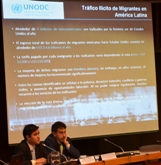Smuggling of Migrants: one step away from Human Trafficking
23 September, 2011 - With a dream in mind and nothing in hands to hold on to. Poverty, natural disasters, conflicts and civil wars, and lack of employment opportunities make, every year, millions of people cross borders in search of a better life. Unable to migrate legally, many use the services of traffickers, and the dream can become brief.
The lack of information and the economic, social and psychological vulnerability of people who risk entering another country in a clandestine manner make them easy targets for organized crime.
Migrant smuggling was one of the issues discussed, during the Second Iberoamerican Prosecutors Summit against Trafficking in Persons, held at the headquarters of the Economic Commission for Latin America and the Caribbean (ECLAC) in Santiago, Chile.
According to Carlos Perez, Project Coordinator of the United Nations Office on Drugs and Crime in Colombia (UNODC), the context in which these people find themselves makes them more vulnerable to human trafficking. "Sometimes, these migrants are locked or are taken hostage until they finish paying, or threats are made to their families left behind in the countries of origin. Traffickers always look for more gains. Then the victims of trafficking are more likely to be victims of human trafficking", said Perez.
Present throughout the world, the smuggling of migrants affects millions of people in Latin America. Every year, about 3 million Latin Americans are trafficked across the South border of the United States. The fee paid by each immigrant to traffickers varies between US $ 2,000 and US $ 10000, depending on the route.
In general, these migrants are young men, although in recent years the number of women has increased significantly. Among the crucial issues to address the problem are prevention, victim protection, promotion of international cooperation and prosecution.
The Summit, organized by the Public Ministry of Chile, the Latin American Association of Public Ministries (AIAMP) and the Meeting of Mercosur Prosecutors (REMPM), was sponsored by UNODC, through the Global Project for the Implementation of the Protocols against human trafficking and against the smuggling of migrants, which has the European Union partnership.
Smuggling of migrants and trafficking
Throughout history, the contexts of human mobility and the commoditization of human beings have also changed the dynamics of human trafficking. While in the past this phenomenon was characterized by slavery through the transatlantic slave trade, nowadays we see the smuggling of migrants and trafficking in persons, including children and adolescents.
Characterized by the exploitation of human vulnerability by criminals for the benefit of a network or an organization, the smuggling of migrants and human trafficking shared other elements such as the desire of victims to leave one place to another in search of better life conditions and the relationship of domination that criminals establish with their victims.
"In these two kinds of human trafficking, victims are treated as objects by smugglers or guides, seeking to obtain material gains or of other order. The use of the same routes, criminal structures and mechanisms for money laundering can also be identified, and often the crimes committed throughout the process are the same, for example, document fraud", explained Perez.
However, there are important differences between the two offenses. The smuggling of migrants consists in facilitating the entry of a person in the destination country without documents or with false documents. This is a transnational crime, which requires the consent of the victim, ending with the arrival of migrants to their final destination. The main income of the dealers is the price paid by the person for the illegal entry and the offense seeks to violate the sovereignty of the State when it requires certain documents of entrance, a requirement that dealers try to avoid.
On the other hand, human trafficking is not necessarily a transnational crime, there is usually no victim's consent and exploitation does not end with the arrival at destination. The higher income of traffickers, in turn, comes from the exploitation of the victim, in ways such as labor or sexual exploitation, organ removal, slavery and forced labor. It is a crime against the dignity and the autonomy of human beings.
Related Information
Access the presentation on Migrant Smuggling (ppt)
Fact Sheet on Trafficking in Persons (Spanish)
United Nations Convention against Transnational Organized Crime
Protocol to Prevent, Suppress and Punish Trafficking in Persons, Especially Women and Children
Protocol against the Smuggling of Migrants by Land, Air and Sea
